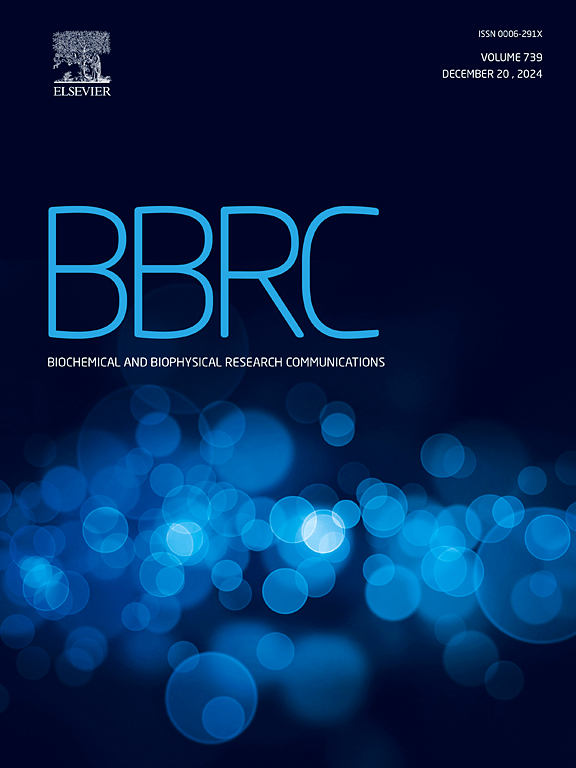Hippocampal transcriptome profiling associated with post-traumatic stress disorder-like behaviors in male mice
IF 2.5
3区 生物学
Q3 BIOCHEMISTRY & MOLECULAR BIOLOGY
Biochemical and biophysical research communications
Pub Date : 2025-06-13
DOI:10.1016/j.bbrc.2025.152205
引用次数: 0
Abstract
Post-traumatic stress disorder (PTSD) is a trauma- and stressor-related disorder characterized by re-experiencing, avoidance of trauma-related stimuli, negative changes in mood and cognition, and hyperarousal. Despite its prevalence, the pathogenesis and molecular mechanisms underlying PTSD remain poorly understood. In the present study, a mouse model simulating PTSD was established through a modified single prolonged stress (SPS) in conjunction with plantar shock (SPS+shock). Contextual fear-like and active avoidance behaviors were assessed using the contextual freezing test and the cue avoidance test, respectively. Four weeks after stress exposure, the SPS+shock mice were categorized into PTSD-like (+) (exhibiting PTSD-like behavioral phenotype) and PTSD-like (-) (lacking the behavioral phenotype) groups. Hippocampal gene expression profiles were obtained through high-throughput RNA sequencing (RNA-seq). Functional enrichment analysis of significantly differentially expressed genes revealed pathways associated with the PTSD-like (+) phenotype, including the Notch signaling pathway and GABAergic synapse. Using the CytoHubba plugin, three hub genes enriched in the Notch signaling pathway and three hub genes enriched in the GABAergic synapse were identified. Additionally, weighted gene co-expression network analysis highlighted key pathways, including the Notch signaling pathway, ATP-dependent chromatin remodeling, histone modification and mitochondrial oxidative phosphorylation. Within these pathways, 16 hub genes were screened out. Additionally, the mRNA expression changes of nine hub genes validated by qPCR, showed similar trends to the RNA-seq data. Collectively, our results found important biological pathways and hub genes associated with the PTSD-like behavioral phenotype in mice, offering potential insights into the pathological mechanisms of PTSD and identifying novel therapeutic targets.
雄性小鼠海马转录组分析与创伤后应激障碍样行为相关
创伤后应激障碍(PTSD)是一种创伤和压力相关的障碍,其特征是重新体验,避免创伤相关刺激,情绪和认知的负面变化以及过度觉醒。尽管其流行,发病机制和分子机制的创伤后应激障碍仍然知之甚少。本研究通过改良单次延长应激(SPS)联合足底休克(SPS+休克)建立模拟创伤后应激障碍的小鼠模型。情境类恐惧行为和主动回避行为分别采用情境冻结测试和线索回避测试进行评估。应激暴露4周后,SPS+休克小鼠被分为ptsd样(+)组(表现出ptsd样行为表型)和ptsd样(-)组(缺乏行为表型)。通过高通量RNA测序(RNA-seq)获得海马基因表达谱。对显著差异表达基因的功能富集分析揭示了与ptsd样(+)表型相关的通路,包括Notch信号通路和GABAergic突触。利用CytoHubba插件,我们鉴定了3个富集于Notch信号通路的枢纽基因和3个富集于gaba能突触的枢纽基因。此外,加权基因共表达网络分析突出了关键通路,包括Notch信号通路、atp依赖性染色质重塑、组蛋白修饰和线粒体氧化磷酸化。在这些途径中,16个中心基因被筛选出来。此外,qPCR验证的9个枢纽基因的mRNA表达变化与RNA-seq数据相似。总的来说,我们的研究结果发现了与小鼠PTSD样行为表型相关的重要生物学途径和枢纽基因,为PTSD的病理机制提供了潜在的见解,并确定了新的治疗靶点。
本文章由计算机程序翻译,如有差异,请以英文原文为准。
求助全文
约1分钟内获得全文
求助全文
来源期刊
CiteScore
6.10
自引率
0.00%
发文量
1400
审稿时长
14 days
期刊介绍:
Biochemical and Biophysical Research Communications is the premier international journal devoted to the very rapid dissemination of timely and significant experimental results in diverse fields of biological research. The development of the "Breakthroughs and Views" section brings the minireview format to the journal, and issues often contain collections of special interest manuscripts. BBRC is published weekly (52 issues/year).Research Areas now include: Biochemistry; biophysics; cell biology; developmental biology; immunology
; molecular biology; neurobiology; plant biology and proteomics

 求助内容:
求助内容: 应助结果提醒方式:
应助结果提醒方式:


